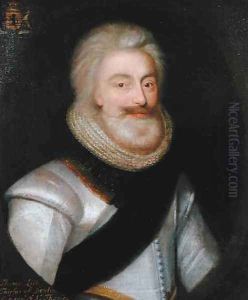George Jameson Paintings
George Jameson, often referred to as George Jamieson, was a Scottish portrait painter born in 1587 in Aberdeen. He is frequently celebrated as the 'Scottish Van Dyck' and is considered the greatest Scottish portrait painter of his era before the late 18th century. Jameson was the son of a master builder and studied in Scotland until he moved to Antwerp. There, he became a pupil of the eminent Flemish painter Sir Anthony van Dyck's master, Peter Paul Rubens. Under Rubens' tutelage, Jameson developed a style that would become the hallmark of his career.
After his apprenticeship with Rubens, he traveled to Italy to further his studies and was greatly influenced by the work of Titian and other Italian masters. Jameson returned to Scotland in 1620 and established himself as a portrait painter in Aberdeen. His works were known for their exceptional detail, clarity, and use of color. He was adept at both miniature and full-scale portraits, with his services being in high demand by the nobility and the well-to-do of Scotland.
Jameson's clientele included not only the local aristocracy but also visitors from abroad. His portraits are characterized by their elegance and often include elements that reflect the interests or status of the sitter. He married Isobel Tosche, with whom he had at least one son, John, who also became a painter, though not as acclaimed as his father.
George Jameson continued to work and produce notable portraits throughout his life. He died in 1644 in Edinburgh and left behind a legacy that would influence Scottish portraiture for generations. His work is represented in several major collections and continues to be studied and admired for its historical significance and artistic merit. Jameson's contribution to Scottish art was not only in his portraits but also in laying the groundwork for future Scottish artists, and he is remembered as a pioneer of the nation's artistic heritage.
